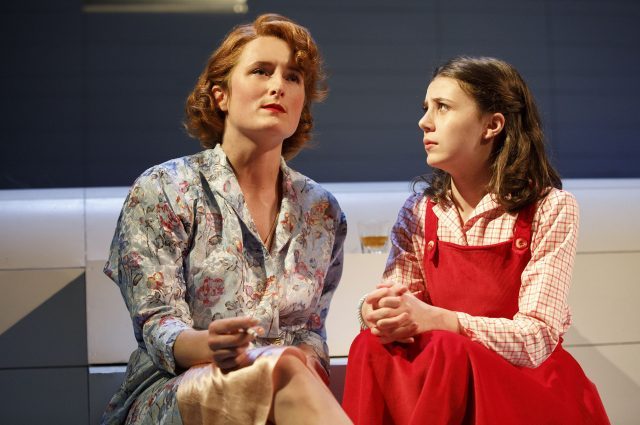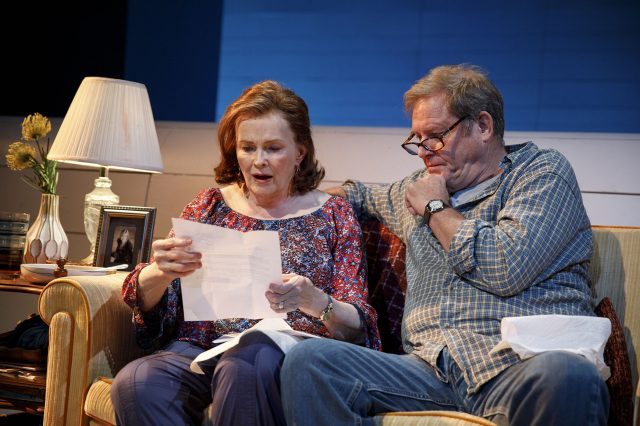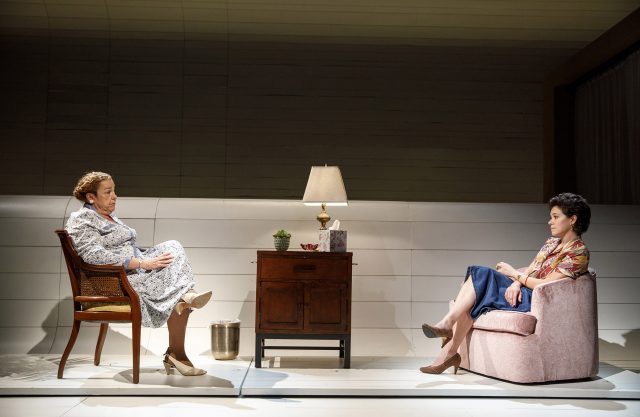
Twelve-year-old Mary Page (Mia Sinclair Jenness) looks up to her mother (Grace Gummer) in extraordinary Tracy Letts play (photo by Joan Marcus)
2econd Stage Theater
Tony Kiser Theater
305 West 43rd St. between Eighth & Ninth Aves.
Tuesday – Sunday through August 19, $30-$89
2st.com/shows
“I am unexceptional,” the title character tells her shrink in Mary Page Marlowe, Pulitzer Prize winner Tracy Letts’s exceptional play, which opened tonight at 2econd Stage’s Tony Kiser Theater. The best play I’ve ever seen about the life and times of a woman written by a man, Mary Page Marlowe follows the protagonist, born in 1946, through eleven nonchronological stages of her rather ordinary existence, portrayed by six terrifically talented actresses and one doll (as the infant). Each scene reveals small but significant details about the character as she goes about her days as a daughter, a wife, a mother, a patient, an employee, and a retiree, trying to find her identity as her relationships — and her name — change. Whether she ever finds her true self — if there even is such a thing — is the question of the play. Mary Page is wonderfully performed by Mia Sinclair Jenness at twelve, Emma Geer at nineteen, Tatiana Maslany (in her New York stage debut) at twenty-seven and thirty-six, Susan Pourfar at forty and forty-four, Kellie Overbey at fifty, and Blair Brown at fifty-nine, sixty-three, and sixty-nine. The nonlinear time shifts are indicated primarily by the character’s clothing (the simple but effective costumes are by Kaye Voyce) and hairstyle as such basic props as beds, tables, couches, and chairs slide on and off Laura Jellinek’s intimate two-level set, making it clear this is about one woman’s interior and exterior changes, not about a changing America.

Fifty-nine-year-old Mary Page (Blair Brown) gets some bad news as Ray (Brian Kerwin) looks on in masterful production at 2econd Stage (photo by Joan Marcus)
From childhood to senior citizenship, Mary Page faces illness, divorce, alcoholism, infidelity, displacement, and more, all with the same attitude, as if various key moments in her life are no different from the rest of her days; sometimes the choices aren’t hers, but even when they are, she is often a spectator, much like the audience. “What do you want?” her teenage daughter, Wendy (Kayli Carter), asks at a Denny’s as her younger brother, Louis (Ryan Foust), plays with a map. “Why can’t you just say what you want?” Wendy repeats when her mother avoids the question. Throughout the ninety-minute intermissionless play, Mary Page says “I don’t know” two dozen times, although she also does provide some answers. When her shrink (Marcia DeBonis) asks her why she hasn’t brought up what she believes to be a certain important issue previously, Mary Page says, “Because it’s not relevant, that’s what I’m telling you, it feels like a different person who was going through that,” eliciting a laugh from the audience since each Mary Page is played by a different actress. She then adds, “I still live life even when you’re not watching me,” as if reminding the audience that there is even more to Mary Page than what is revealed onstage, just as there is more to any woman we see in real life. But even when she does — or doesn’t — take action for her own benefit, she shows a resilience to persist, a well-earned survival instinct that keeps her going despite what are sometimes formidable odds.

Thirty-six-year-old Mary Page (Tatiana Maslany) faces off against her shrink (Marcia DeBonis) in dazzling New York premiere (photo by Joan Marcus)
Letts (August: Osage County, Superior Donuts) and director Lila Neugebauer, who has excelled helming such ensemble pieces as The Antipodes, Everybody, The Wolves, and The Wayside Motor Inn, do a beautiful job moving from scene to scene; even though events happen out of order, Mary Page is in a constant state of progression. We might not ever see them together (at least not until the curtain call), but the six amazing women who play Mary Page flow into one another seamlessly, helping make her one person with many distinct aspects. The large cast also includes Grace Gummer as Mary Page’s mother and Nick Dillenburg as her father; Audrey Corsa and Tess Frazer as her high school friends, Connie and Lorna; David Aaron Baker and Brian Kerwin as significant others Ray and Andy; Maria Elena Ramirez as her nurse; Gary Wilmes as one of her lovers; and Elliot Villar as her dry cleaner, who wraps everything up as they talk about fixing a quilt in which “different women would sew the different panels and then stitch them all together,” just as Letts, Neugebauer, and the cast have so remarkably done in this extraordinary work.